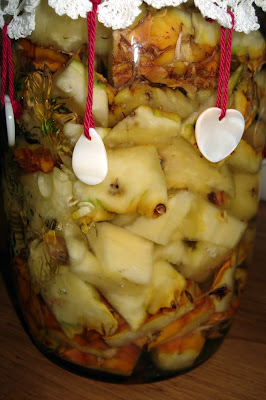You would have noticed some pineapple in a jar sitting next to the beetroot yesterday. That is the first stage of pineapple vinegar I'm making from scratch. It's another great skill to have because it will mean you use the entire pineapple, not just the juicy, sweet inside. Pineapple vinegar is made from the bits you usually throw in the compost bin, but here you can put them to work for you instead of wasting a lot of the pineapple.
Start with a good pineapple - if it's organic, that's great, but you can use an ordinary pineapple from the market. Cut the top off - if you're in a warm climate, you can plant the top and grow your own pineapple - they take two years to fruit. But back to the kitchen, get your vegetable brush and thoroughly clean the pineapple skin. Rinse off and cut the skin from the pineapple. Cut the pineapple in quarters and cut out the core. You can use the pineapple flesh for any of your usual dishes, you don't need to add it to the vinegar jar.
Chop up the core and skin and put the pieces into a large jar. Mix ¼ cup of sugar in a litre/quart of water and pour it over the pineapple skin. Cover with a cotton cloth. This is a recipe where you're using the wild yeasts and bacteria in the air to help ferment the fruit and sweet water, so you don't want to put a lid on it, you want to keep bugs out and allow the yeasts in. Leave the pineapple jar sit to on the kitchen bench for a few weeks.
After two or three week, this mix might turn brown and then go clear again. That's good! It might also develop a little mould on top, that's fine too. Just scoop it off with a clean spoon. If a greyish gelatinous blob forms on the top of the vinegar, either as it's sitting on the bench or after it's bottled, that's excellent, you've made mother of vinegar. And you can use that mother as a starter to make more vinegar.
Two things are important in vinegar making - the temperature in the room it's made in and oxygen, another reason not to put a lid on the jar. The ideal temperature is between 15C - 25C degrees (60F - 80F). If the temperature is too low, it will take longer to make and won't be as good, and if it's too high, I doubt you'll make mother, but the vinegar will still be fine to use. You can introduce oxygen into the vinegar simply by stirring it every day.
Taste the vinegar after a couple of weeks, it should already be vinegary, you can then remove the pineapple pieces and put them in the compost. Leave the vinegar on the bench for another two weeks to develop the complex character of good vinegar. When you're happy with the taste, strain the vinegar through a clean cotton cloth two or three times and store it in a clean bottle with the lid on. It's perfectly okay to use this as it is, in fact it's a healthier alternative to the regular store bought vinegar. However, if you want to store the vinegar for a long time, you'd best pasteurise it. You do that simply by boiling it in a water bath, the guidelines for pasteurising at home are here. I keep my home made vinegar in the cupboard and use it within about two months.
Pineapple vinegar is excellent as part of a salad dressing and especially good to make a salsa dressing. You could use it to preserve your beetroot or bread and butter cucumbers. It's also a nice gift for someone who likes to cook. This is really easy to make and I encourage you to try it. I'm sure you'll be surprised at the results you get, and it's one more step on the self reliance trail.





